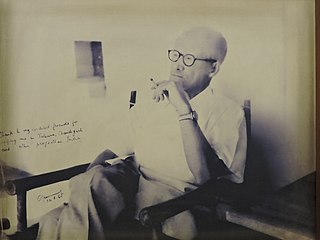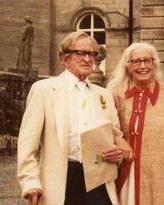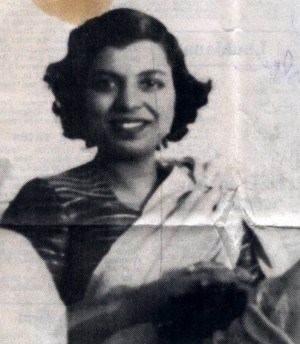
Charles-Édouard Jeanneret, known as Le Corbusier, was a Swiss-French architect, designer, painter, urban planner, writer, and one of the pioneers of what is now regarded as modern architecture. He was born in Switzerland and became a French citizen in 1930. His career spanned five decades, and he designed buildings in Europe, Japan, India, and North and South America. He considered that "the roots of modern architecture are to be found in Viollet-le-Duc".

Chandigarh is a union territory and planned city in India. Chandigarh is bordered by the State of Punjab to the north, west and the south, and by the State of Haryana to the east, the states for which it serves as the capital. It constitutes the bulk of the Chandigarh Capital Region or Greater Chandigarh, which also includes the adjacent satellite cities of Panchkula and Mohali. It is located 260 km north of New Delhi and 229 km southeast of Amritsar.

Nek Chand Saini was a self-taught Indian artist, known for building the Rock Garden of Chandigarh, an eighteen-acre sculpture garden in the city of Chandigarh.

Panjab University (PU) is an Indian collegiate public state university located in Chandigarh. Funded through both State and Union governments, it is considered a state university. It traces its origins to the University of the Punjab in Lahore, which was founded in 1882. After the partition of India, the university was established on October 1, 1947, and called East Punjab University. Initially housed primarily at a cantonment in Solan, it later relocated to a newly built campus in Chandigarh, and was renamed Panjab University.

Pierre Jeanneret was a Swiss architect who collaborated with his cousin, Charles-Édouard Jeanneret, for about twenty years.

Sukhna Lake in Chandigarh, India, is a reservoir at the foothills of the Himalayas. This 3 km² rainfed lake was created in 1958 by damming the Sukhna Choe, a seasonal stream coming down from the Shivalik Hills. Originally, the seasonal flow entered the lake directly causing heavy siltation. To check the inflow of silt, 25.42 km² of land was acquired in the catchment area and put under vegetation. In 1974, the Choe was diverted and made to bypass the lake completely, the lake being fed by three siltation pots, minimizing the minimizing silt into the lake itself.

Edwin Maxwell Fry, CBE, RA, FRIBA, FRTPI, known as Maxwell Fry, was an English modernist architect, writer and painter.
Dera Bassi is a satellite city of Chandigarh and a municipal council in Mohali district in the state of Punjab, India. Dera Bassi is located on the Chandigarh – Delhi National Highway, 8 km from Chandigarh. It is located within 20 km from Chandigarh, Mohali and Panchkula. It is strategically located near the boundary of Haryana, Punjab and Union territory of Chandigarh. Derabassi is most famous for its industrial belt, situated for the most part on Ramgarh and Barwala Road. The nearby sub town of Lalru was once a famous market for red chilli powder. The city and the nearby area host eight Engineering, B.Ed., Paramedical and Management institutes.

Dame Jane Drew, was an English modernist architect and town planner. She qualified at the Architectural Association School in London, and prior to World War II became one of the leading exponents of the Modern Movement in London.

Government Museum and Art Gallery, Chandigarh, is a premier museum of North India having collections of Gandharan sculptures, sculptures from ancient and medieval India, Pahari and Rajasthani miniature paintings. It owes its existence to the partition of India in August, 1947. Prior to the partition, much of the collections of art objects, paintings and sculptures present here were housed in the Central Museum, Lahore, the then capital of Punjab. The museum has one of the largest collection of Gandharan artefacts in the world.

The Rock Garden of Chandigarh is a sculpture garden for rock enthusiasts in Chandigarh, India. It is also known as Nek Chand Saini's Rock Garden of Nathupur after its founder Nek Chand Saini, a government official who started building the garden secretly in his spare time in 1957. It has spread over an area of 40 acres (16 ha), and is completely built from industrial, home waste, and discarded items.

The Pavillon Le Corbusier is a Swiss art museum in Zürich-Seefeld at Zürichhorn dedicated to the work of the Swiss architect Le Corbusier. In 1960 Heidi Weber had the vision to establish a museum designed by Le Corbusier – this building should exhibit his works of art in an ideal environment created by the architect himself in the then Centre Le Corbusier or Heidi Weber Museum. In April 2014 the building and museum went over to the city of Zürich, and was renamed in May 2016.
Founded in 1989, the Galerie Patrick Seguin is an art gallery and exhibition space located in Paris's La Bastille district. Its current space has been designed by Ateliers Jean Nouvel. The gallery distributes the creations of designers and architects Jean Prouvé, Charlotte Perriand, Pierre Jeanneret, Le Corbusier, Jean Royere.In this capacity the gallery is urged by museums to contribute to exhibitions, especially:the Centre Georges Pompidou in Paris, MoMA in New York, the Vitra Design Museum in Weil am Rhein, the Museum of Decorative Arts in Paris, the Museum of Fine Arts in Nancy, the Venice Architecture Biennale.
Patrick Seguin is a French gallery owner specialised in French architect-designed furniture of the 20th century, and founder of Galerie Patrick Seguin. In recognition of his work, Patrick Seguin was named ‘Chevalier de l’Ordre des Arts et des Lettres’ by the French Ministry of Culture in March 2017. He is also a member of the Compagnie Nationale des Experts and of the Syndicat National des Antiquaires.

Aditya Prakash, was an architect, painter, academic and published author. He belonged to the first generation of Indian Modernists closely associated with Chandigarh and the developmentalist practices of postcolonial India under Jawaharlal Nehru. He designed over 60 buildings all in north India. His paintings are held in private collections worldwide. His architecture and art adhered strictly to modernist principles. As an academic, he was one of the earliest Indian champions of sustainable urbanism. He published two books and several papers on this topic. His archives are held at the Canadian Centre for Architecture at Montreal, Canada.

Urmila Eulie Chowdhury was an Indian architect who worked during the mid-to-late 20th century. She worked in the fields of general architecture, landscape architecture and design, and was also a teacher and writer. She was a pioneer woman architect working in India. Some sources state that she was also the first female architect in Asia. After her education she worked in close collaboration with Le Corbusier in the planning design and construction of the city of Chandigarh.

Parmeshwari Lal Varma, often shortened to P. L. Varma, is an Indian civil engineer and a former chief engineer of Punjab. He served as an associate of Le Corbusier, the Swiss-French architect, who designed the city of Chandigarh. There have been reports that Le Corbusier wanted Verma to assist him even past his retirement from service for which Jawaharlal Nehru, the then prime minister of India, unsuccessfully requested the Government of Punjab for the extension of Verma's service. His involvement in the making of Chandigarh has been documented in a book, Le Corbusier Rediscovered: Chandigarh and Beyond, in which he has written a special article. The Government of India awarded him Padma Bhushan, the third highest Indian civilian award, in 1971. In June 2001, The Tribune noted that Verma was deceased.

New Chandigarh is a new planned smart city near Mullanpur in the Mohali district in Punjab, India. It has been designed as an extension of the city of Chandigarh. It is developed by the Greater Mohali Area Development Authority. A digital land survey was started by using a drone on 26 April 2018 and was completed on 24 June 2018. Initial Master of city is divided in sectors numbering 1 to 21.

Morni Fort is a nature museum and learning centre situated about 45 km from Chandigarh. The 200 years old Morni fort in Morni hills was transformed into a museum at a cost of over INR 1 crore.
Government Model high School, Sector-25 is a State-funded co-educational secondary school located in Chandigarh, India, educating students in grades K–12. Founded in 1954 it is the oldest school in Chandigarh and among the most selective. The school is affiliated to the Central Board of Secondary Education and offers twenty-three subjects at the AISSCE level, among the highest for any school in the region. It also claims a 100% pass percentage at the All India School Certificate Examination level.


















